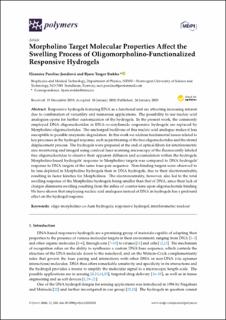| dc.contributor.author | Jonasova, Eleonora Parelius | |
| dc.contributor.author | Stokke, Bjørn Torger | |
| dc.date.accessioned | 2020-06-22T08:24:03Z | |
| dc.date.available | 2020-06-22T08:24:03Z | |
| dc.date.created | 2020-06-18T12:01:16Z | |
| dc.date.issued | 2020 | |
| dc.identifier.citation | Polymers. 2020, 12 (2), 268 | en_US |
| dc.identifier.issn | 2073-4360 | |
| dc.identifier.uri | https://hdl.handle.net/11250/2658958 | |
| dc.description.abstract | Responsive hydrogels featuring DNA as a functional unit are attracting increasing interest due to combination of versatility and numerous applications. The possibility to use nucleic acid analogues opens for further customization of the hydrogels. In the present work, the commonly employed DNA oligonucleotides in DNA-co-acrylamide responsive hydrogels are replaced by Morpholino oligonucleotides. The uncharged backbone of this nucleic acid analogue makes it less susceptible to possible enzymatic degradation. In this work we address fundamental issues related to key processes in the hydrogel response; such as partitioning of the free oligonucleotides and the strand displacement process. The hydrogels were prepared at the end of optical fibers for interferometric size monitoring and imaged using confocal laser scanning microscopy of the fluorescently labeled free oligonucleotides to observe their apparent diffusion and accumulation within the hydrogels. Morpholino-based hydrogels’ response to Morpholino targets was compared to DNA hydrogels’ response to DNA targets of the same base-pair sequence. Non-binding targets were observed to be less depleted in Morpholino hydrogels than in DNA hydrogels, due to their electroneutrality, resulting in faster kinetics for Morpholinos. The electroneutrality, however, also led to the total swelling response of the Morpholino hydrogels being smaller than that of DNA, since their lack of charges eliminates swelling resulting from the influx of counter-ions upon oligonucleotide binding. We have shown that employing nucleic acid analogues instead of DNA in hydrogels has a profound effect on the hydrogel response. | en_US |
| dc.language.iso | eng | en_US |
| dc.publisher | MDPI | en_US |
| dc.rights | Navngivelse 4.0 Internasjonal | * |
| dc.rights.uri | http://creativecommons.org/licenses/by/4.0/deed.no | * |
| dc.title | Morpholino target molecular properties affect the swelling process of oligomorpholino-functionalized responsive hydrogels | en_US |
| dc.type | Peer reviewed | en_US |
| dc.type | Journal article | en_US |
| dc.description.version | publishedVersion | en_US |
| dc.source.volume | 12 | en_US |
| dc.source.journal | Polymers | en_US |
| dc.source.issue | 2 | en_US |
| dc.identifier.doi | 10.3390/polym12020268 | |
| dc.identifier.cristin | 1816133 | |
| dc.description.localcode | This is an open access article distributed under the Creative Commons Attribution License which permits unrestricted use, distribution, and reproduction in any medium, provided the original work is properly cited. | en_US |
| cristin.ispublished | true | |
| cristin.fulltext | original | |
| cristin.qualitycode | 1 | |

